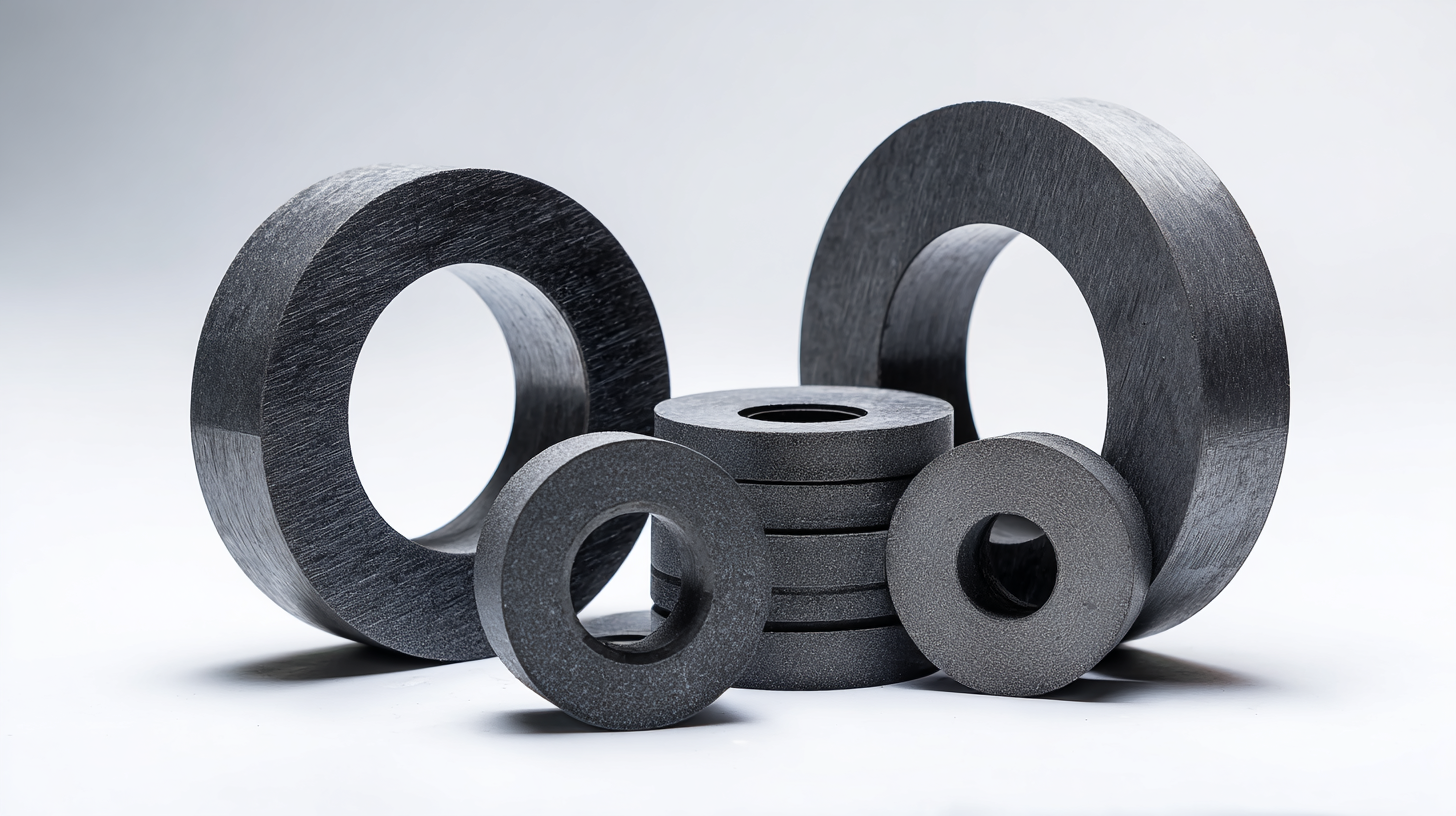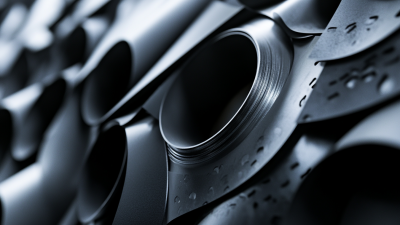Top 5 Benefits of Using Flexible Graphite Gaskets for Industrial Applications
In the ever-evolving landscape of industrial applications, the choice of materials plays a critical role in ensuring efficiency and reliability. One such material that has garnered significant attention is the Flexible Graphite Gasket. According to a report by Market Research Future, the global gasket market is projected to reach USD 15.5 billion by 2025, with flexible graphite gaskets anticipated to capture a substantial share due to their superior sealing properties and resistance to extreme temperatures.

Flexible Graphite Gaskets offer unparalleled advantages, such as outstanding chemical resistance and the ability to maintain integrity under harsh conditions, making them indispensable in sectors like petrochemical, power generation, and food processing.
The use of Flexible Graphite Gaskets not only enhances performance but also reduces maintenance costs, a factor highlighted in various industry analyses. A study published by the Global Gasket Manufacturer's Association notes that the implementation of high-quality gaskets can decrease downtime by up to 30%, directly impacting productivity and profitability.
As industries increasingly prioritize sustainability and cost-effectiveness, understanding the benefits of Flexible Graphite Gaskets becomes pivotal for decision-makers aiming to optimize their operations while adhering to regulatory standards. This article explores the top five benefits of employing Flexible Graphite Gaskets in industrial applications, aiming to provide insights that can lead to informed choices and enhanced operational efficiency.
Enhanced Sealing Performance in Extreme Conditions
 Flexible graphite gaskets are becoming the preferred choice in various industrial applications, particularly when it comes to enhancing sealing performance in extreme conditions. Unlike traditional gasket materials, flexible graphite exhibits exceptional thermal and chemical stability, making it well-suited for environments with high temperatures and aggressive chemicals. According to a study by the American Society of Mechanical Engineers (ASME), gaskets made from flexible graphite can maintain integrity at temperatures exceeding 450°C (842°F), considerably outperforming conventional materials.
Flexible graphite gaskets are becoming the preferred choice in various industrial applications, particularly when it comes to enhancing sealing performance in extreme conditions. Unlike traditional gasket materials, flexible graphite exhibits exceptional thermal and chemical stability, making it well-suited for environments with high temperatures and aggressive chemicals. According to a study by the American Society of Mechanical Engineers (ASME), gaskets made from flexible graphite can maintain integrity at temperatures exceeding 450°C (842°F), considerably outperforming conventional materials.
Moreover, the resilience of flexible graphite gaskets helps minimize leakage, which is crucial in industries where fluid containment is paramount. The Industrial Engineering Journal reported that effective sealing solutions can reduce operational downtime by up to 32%, significantly impacting a facility's bottom line. This is particularly vital in sectors such as oil and gas, where fluid leakage can lead to safety hazards and substantial financial losses.
Tips: When choosing flexible graphite gaskets, ensure compatibility with the specific chemicals and temperature ranges in your application. Regular inspections can also help maintain optimal sealing performance, allowing you to catch potential issues before they escalate. Additionally, always consult manufacturer specifications to select the right thickness and density for your operational needs to maximize performance.
Increased Longevity and Cost Efficiency of Gaskets
Flexible graphite gaskets offer significant advantages, particularly in terms of increased longevity and cost efficiency in industrial applications. With an ability to withstand extreme temperatures and pressures, these gaskets reduce maintenance needs and operational downtime significantly. A study from the U.S. Department of Energy highlights that upgrading sealing technology in centrifugal compressors can lead to enhanced efficiency, thereby extending the lifespan of gaskets and reducing long-term costs. By minimizing leakage and ensuring a tighter seal, flexible graphite gaskets contribute to consistent performance and reduced energy consumption.
Moreover, the growing demand for sustainable practices in industries is pushing the importance of material durability. Flexible graphite gaskets can endure harsh conditions and resist degradation, which is crucial in applications where equipment failure could lead to not only financial loss but also environmental concerns. As noted in the automotive and HVAC sectors, the push for innovative sealing solutions can help mitigate issues from aging infrastructure. Reports suggest that properly maintained and technologically advanced gaskets and seals could improve operational efficiency immensely, aligning with the industry's focus on sustainability and cost-effectiveness.
Improved Flexibility Leading to Better Fit and Reduced Leakage
Flexible graphite gaskets have gained popularity in various industrial applications due to their exceptional flexibility, which leads to improved fits and reduced leakage. Recent industry reports indicate that improper gasket fitting accounts for up to 30% of leakage issues in industrial systems. This highlights the critical nature of gaskets in maintaining the integrity of connections and preventing costly downtime.
The inherent flexibility of graphite gaskets allows them to easily adapt to the surface contours of flanges, effectively filling gaps and ensuring a tight seal. This adaptability is essential in high-temperature and high-pressure environments, where other gasket materials may fail. According to a study by the Gasket Manufacturers Association, flexible graphite gaskets can withstand temperatures up to 450°C (842°F) and compressive loads above 25 MPa, making them ideal for demanding industrial applications.
**Tips:** When selecting flexible graphite gaskets, ensure that the material is compatible with the fluid or gas being sealed. Additionally, proper installation is crucial; always follow manufacturer guidelines for torque specifications to achieve optimal sealing performance. Regularly inspect gaskets during maintenance checks to identify any wear or damage early, promoting a longer service life and minimizing leakage risks.

Resistance to Chemical Corrosion for Diverse Industrial Environments
Flexible graphite gaskets are increasingly recognized for their exceptional resistance to chemical corrosion, making them an ideal choice for a wide range of industrial applications. In environments where exposure to harsh chemicals is inevitable, these gaskets demonstrate outstanding durability and reliability. Unlike conventional materials, flexible graphite can withstand extreme pH levels and aggressive substances, providing a robust seal that prevents leaks and enhances system integrity.
Moreover, the unique properties of flexible graphite allow for excellent thermal and mechanical performance, further supporting their use in various settings, from oil and gas to chemical processing. Their ability to conform to irregular surfaces ensures a tight, leak-proof seal, even under fluctuating pressure and temperature conditions. This versatility not only helps in maintaining operational efficiency but also reduces the risk of equipment failure, ultimately leading to safer and more cost-effective industrial processes.
Top 5 Benefits of Using Flexible Graphite Gaskets for Industrial Applications
Flexible graphite gaskets are widely favored in various industrial environments due to their unique properties. The following chart illustrates the top five benefits of using flexible graphite gaskets, emphasizing their resistance to chemical corrosion and overall performance in different applications.
Simplified Installation Process and Maintenance Requirements
Flexible graphite gaskets offer a streamlined installation process that significantly enhances efficiency in industrial applications. Unlike traditional gaskets, which may require precise fitting and extensive modifications to surfaces, flexible graphite gaskets can conform easily to uneven or damaged surfaces. This adaptability not only simplifies the installation but also reduces labor time, allowing for quicker project turnaround. The lightweight nature of graphite gaskets further aids in handling and positioning, making them a preferred choice for maintenance teams.
Moreover, the maintenance requirements associated with flexible graphite gaskets are minimal, contributing to overall operational savings. Once installed, these gaskets exhibit excellent resistance to thermal cycling and compression set, which means they maintain their sealing ability over time without requiring frequent checks or replacements. This durability minimizes downtime and enhances productivity, making them ideal for high-performance applications in industries such as oil and gas, chemical processing, and power generation. The combination of easy installation and low maintenance ensures that facilities can operate smoothly, focusing on core production goals rather than ongoing gasket management.
Related Posts
-

Real-World Applications of the Best Graphite Gasket Sheet in Various Industries
-

5 Essential Tips for Choosing the Right Flexible Graphite Gasket for Your Applications
-

Top Strategies for Sourcing the Best Graphite Natural in the Industry
-

Unveiling the Advantages of Choosing Graphite Paper over Carbon Paper for Your Projects
-

Maximizing Value with Best Thermal Graphite Sheets: Service Benefits and Future Repair Innovations
-

Challenges Faced by Industries When Using Flexible Graphite Sheets